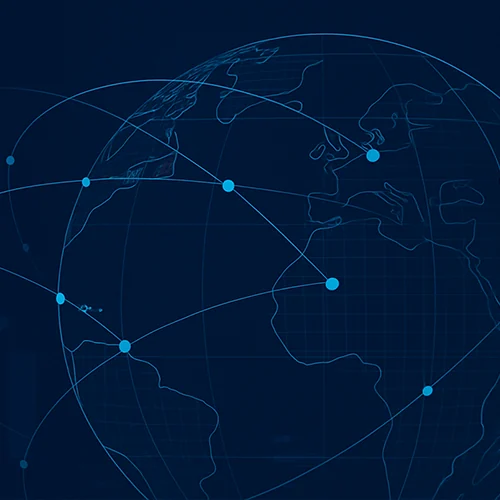April 9, 2025
How Will Tariffs Change Your Supply Chain?

Transcript
Given the tariffs announced last week, it’s unlikely that any supply chain moving forward in 2025 will look like it did in 2024. The question is: how will tariffs impact your supply chain? To help us make sense of this information, today’s podcast features an expert who has his ear to the ground when it comes to supply chain challenges and what smart leaders are saying we should do in this changing climate. Ron Crabtree is the host of the MetaPod podcast where he talks with supply chain experts from around the world about the challenges of building a modern, resilient supply chain. He’s also the CEO of MetaOps, helping organizations clear operational challenges like the one facing all of manufacturing today.
So let’s start with the buzz. What are you hearing around the current tariff changes and what they mean for manufacturing?
Ron Crabtree: Well, if I could sum it up in one word, that word would be yikes.
As leaders, the big challenge for us is to really understand the true cost of tariffs not only from a monetary perspective, but also from a social perspective and a perception perspective with our customers and our suppliers. The first step is having a true understanding of the actual detail costs all the way up the supply chain. I’ve got my suppliers, they have their suppliers, and their suppliers suppliers are also in play. You got to really understand what your obligations are and the risks you’re facing as an enterprise. And then you look downstream to customers. What do they expect from you? Are they going to allow you to pass through price increases to cover those additional costs, or are they going to fight you tooth and nail? It’s devilishly difficult and complex to say the least.
Leah Archibald: So how are organizations wrapping their minds around this complexity?
Ron Crabtree: First off, we have to make sure we’re skilled up to deal with this sort of a challenge. So this is where we’re looking to the purchasing organization, typically. Do we have individuals on the purchasing team who are very conversant with things like incoterms — who have the depth and understanding of what it really means for this given tariff change. For example, the tariff being applied to goods coming out of China: What does that really mean to us and does that impact us? For example, something that’s been going on quite a bit is Chinese suppliers have actually been standing up manufacturing facilities in Mexico. So it’s very obvious what they’re trying to do. You can ship stuff under the NAFTA agreement because the product’s actually being brought into Mexico, value add being applied, and then shipped into the US with reduce tariffs.
Another thing that organizations are really looking hard at is this notion of nearshoring and reshoring. Nearshoring and reshoring is really easy to talk about, but it’s really hard to do because there’s some pieces to this that can be a real problem. First of all, prices were likely to go up. The other thing that can come into play is if I’m late to the party and my competition’s already begun reshoring they’re gobbling up all the capacity of these potential suppliers that are domestic. Maybe I’m too late to the party even now if I’m reacting to that. And then watch out for big problems with shortages of supply. For example, if everybody’s trying to onshore, nearshore, to a relatively few number of suppliers, they’re not going to have the capacity to deal with all that.
Two Strategies to Respond to Tariffs:
- Design for Supply Chain
- Kiosk operations
Ron Crabtree: One of the things that I would recommend that you look at is this notion of changing the design of the product or service to specify a different sort of supply that avoids supply zones impacted by tariffs. Another strategy I’ve seen that works pretty well is what I call kiosk operations. And here’s what I mean by that. If somehow you can get the raw materials domestically instead of using an offshore organization to do the value add, could they in effect set up a similar operation inside your four walls and actually do the value add part for you as a service, thereby employing US nationals as opposed to Chinese nationals, for example? And could we use that as a strategy to kind of get our cake and eat it too? If we’ve got the space for that and have the willingness of a partner from overseas, we can effectively to co-manufacture the goods in the US that today would be very expensive where tariffs are applied.
Leah Archibald: Your first suggestion – retooling your product for a specific supply chain – might even be called design for supply chain management. We talk a lot about designing the product to reduce cost in different cost tradeoff areas such as mass or assembly, but the idea of thinking about supply chain risk early in product design is another layer.
Ron Crabtree: Well you’re really onto something there. The possibilities of tariffs, both tariffs imposed by the United States and retaliatory tariffs imposed by other countries, are something we need to consider in design. We have to design with these particular supply points in mind. If you design that we can’t readily and easily resource or source from a different part of the world, that’s going to be a problem. So that’s a longer term view that is very, very important. The other thing that’s really important is how can we innovate the existing products and services? And are there things we could do in the short run without completely redesigning the product from scratch to make an impact on that.
I’ll just share a quick story here. I used to run purchasing for a division of United Technologies Automotive. We made headliners for inside roof of the vehicle. We had this really large headliner we were producing for Chrysler at the time and we were running really hard six, seven days a week, just having a real hard time keeping up with volume. There’s a napped nylon textile with some foam on the back then fiberglass and some glue. And on the back of this there was what we called a scrim. It was basically the back woven product that would be between the actual steel and the beginning of this headliner substrate. And we had a problem with the phenolic resins that we would spray on this, that would then be baked into shape, would migrate through the woven fabric onto the tooling. So we were having to stop production once a week and have people literally crawl inside these tools and scrape this glue off so that we could get back into production. It was impacting capacity and it was creating a real problem. So I had a supplier show up and he looks at me and he says, you know what, have you considered using a non-woven instead of a woven textile for this? He says: we have a paper like process where we can create something that looks like a roll of textile, but it has similar properties. But better yet, it would stop the glue from migrating through to the tooling. So we actually got that trialed and we found out that we could essentially stop the migration of the adhesives, so our scrap went way down. And our downtime associated with dealing with this problem went way down. And here’s the best part: the product was actually cheaper than the woven.
Leah Archibald: Now that sounds like a success story of supplier collaboration. What does it take to make that happen?
Ron Crabtree: It takes the willingness to challenge the status quo and to be open to uncovering other opportunities. And all these tariffs are just making things more volatile, so we need to think in terms of continuous innovation on existing products and services.
Leah Archibald: What advice would you give to supply chain leaders as they deal with the shifting changes or current tariffs?
Ron Crabtree: Well, for sure you want to get really good at modeling. You need to know which of your suppliers are actually affected by each tariff. From there, can you extrapolate that and come up with a good model of impact? Does it put us out of business? Does it cut our profit margins by half a percent? And then after that you have to figure out how to model that if you’re going to make changes.
There are two questions that are really important from a modeling perspective. The first is: Do we have the data to even do the modeling? The second is: How do we incorporate technologies to help us quickly go through and make those changes?
Two Questions to Ask Procurement:
- Do we have the data to model the impact of tariffs?
- Do we have the technology to help us quickly make changes?
Leah Archibald: At the top of our conversation you said yikes is the word you would use to sum up the situation. Do you feel like there’s a lot of fear or apprehension within sourcing teams today, or do you think this is all of a piece of what we’ve been through over the past several years with supply chain shocks and material shortages? Is this really just what the job of supply chain management is these days, dealing with these unpredictable events and figuring out how to have access to the data to make the best decisions in an insecure climate?
Ron Crabtree: Yes, I’d say for the most part this is not new. For folks that have been in the supply chain business for 10 or more years, we have been through a cycle or two of this already. We had the first Trump administration, then we had the COVID pandemic. So I don’t think it’s like: oh, this is a whole new problem. But the pace of change is increasing, and what we don’t know is what can really hurt us.






